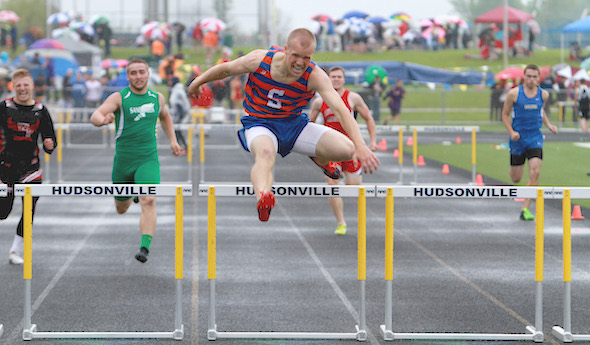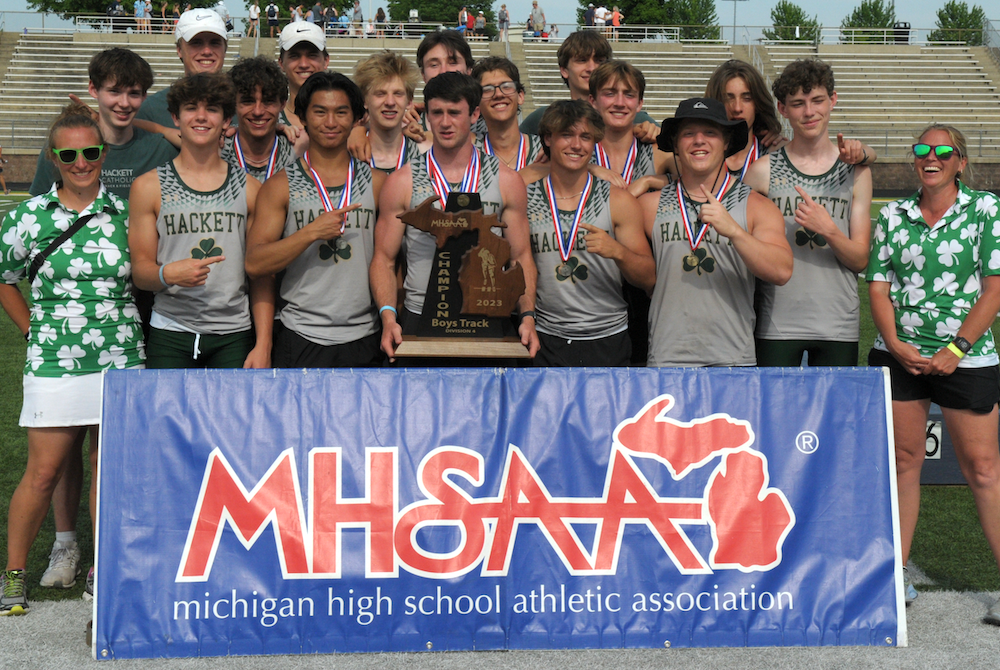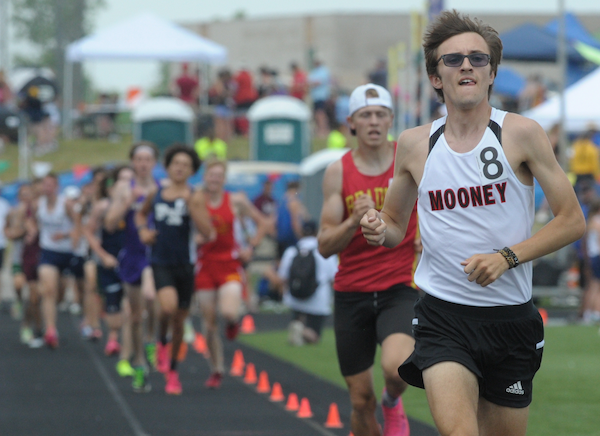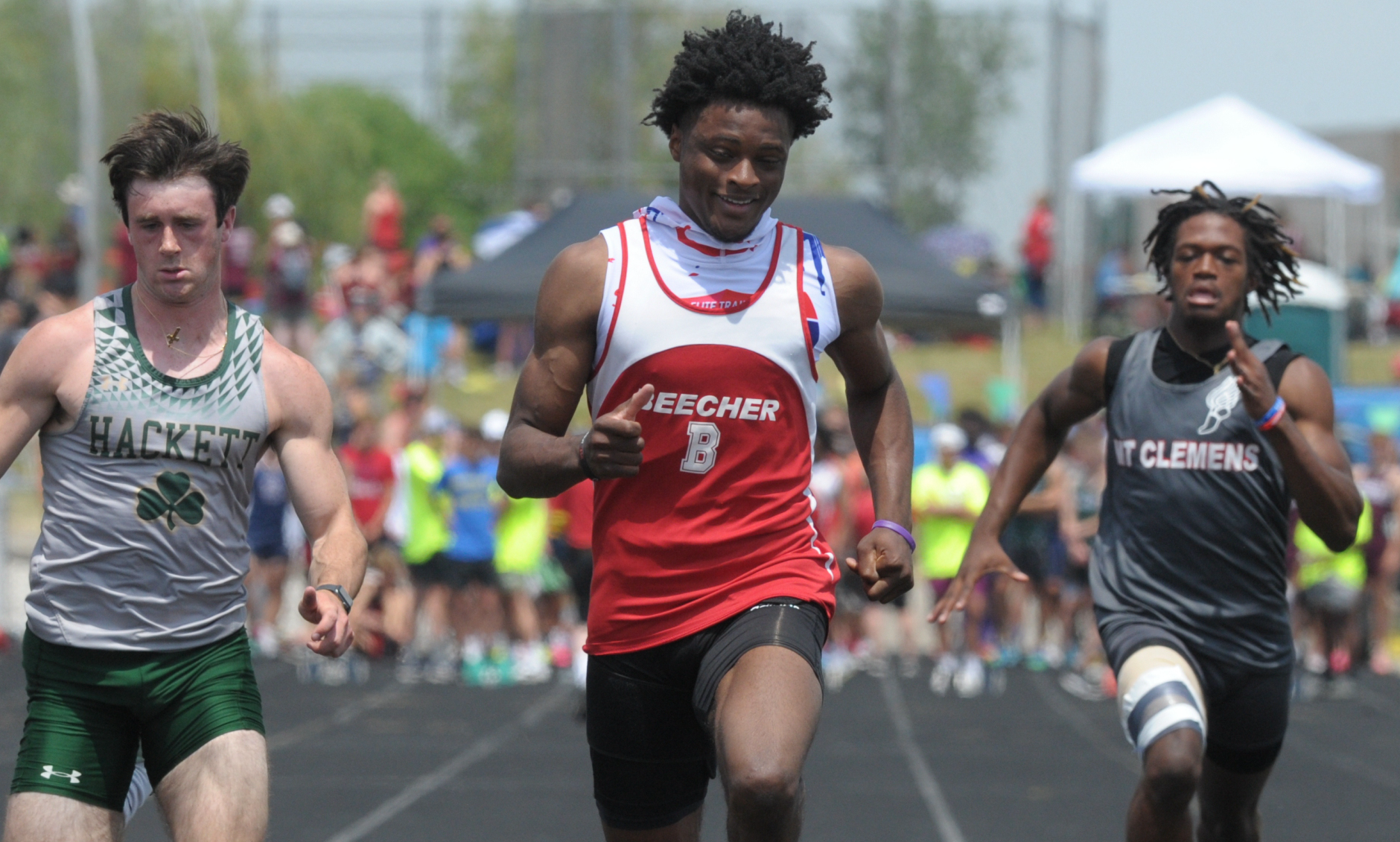
Small-School Powers Tie for LPD4 Title
May 30, 2015
By Dean Holzwarth
Special for Second Half
HUDSONVILLE – The Saugatuck boys track and field team believed it had to settle for another second-place finish at Saturday’s MHSAA Lower Peninsula Division 4 Final at Hudsonville’s Baldwin Middle School.
A late scoring change created hysteria among the squad.
After originally thinking it had fallen one point shy, a correction was made in the final 1,600 relay results that created a tie at the top between Saugatuck and defending champion Concord.
Both teams wound up finishing with 40 points, thus sharing the MHSAA Final crown. Muskegon West Michigan Christian placed third with 39 points.
“We saw coach Bauer run out of the tent holding up the No. 1 finger and everybody just exploded,” said Saugatuck sophomore Blake Dunn, who anchored the winning 1,600 relay team. “It was so sweet, and I’ve never had a feeling like that before. It was amazing.”
The Indians finished a distant second to Concord a year ago. They won the MHSAA Final in 2013.
“We got second last year and we were so down about it,” said Dunn, who also won the 300 hurdles in a time of 39.31 seconds. “There is such a difference between second and first, and when he came out of the tent it was the greatest feeling ever.
“I ran pretty well, but it comes down to the whole team thing. Without my teammates running as well as they did, then we don’t get first place. It’s not all me, and every point matters.”
Saugatuck coach Rick Bauer became emotional after learning his team had won after an official inadvertently forgot to factor in the results of another heat.
“We put so much into this, and this is our life,” Bauer said. “And to see their reaction after they found out they won, that’s really what it is about. It’s a big relief, and it’s like a weight getting lifted off your shoulders.
“Now they get to shave my head. I told them if they won then they could shave my head, and it’s the best haircut you could ever get.”
Concord used a balanced effort to share the crown and repeat.
“That was really exciting,” Concord coach Mark Hersha said. “A lot of teams had a chance, so we knew we had to perform really well to give ourselves the best chance. Our kids responded pretty well, and we had a lot of kids scoring and a lot of kids performing really well.”
 Concord graduated seven from last season, but Hersha said a group of young kids stepped up and filled those shoes.
Concord graduated seven from last season, but Hersha said a group of young kids stepped up and filled those shoes.
Veteran leadership also factored in as senior Jesse Hersha won the 3,200 (9:39.87) and finished runner-up in the 1,600.
“I’m really happy for our team,” Jesse Hersha said. “It wasn’t as deep as last year, but we put in the work and we had a lot of guys step up when we needed it. I was happy to be a part of it and earn some points for my team today.
Harbor Springs senior Luke Anderson wrapped up a stellar career with a pair of victories. He claimed top honors in the 800 (1:57.31) and repeated in the 1,600 (4:17.77).
Anderson also took third in the 3,200.
“The only better way to cap it off would have been to run a second faster in that 1,600, but God was good to me today; I will tell you that,” Anderson said. “My goal was to help my team do well, and I wanted to run a season-best in the mile. I did that, and my goal for the 800 was to win it. Not time or anything else, just win it. I couldn’t be happier.”
Another multi-winner was Union City senior Austin Watson, who blazed to wins in the 100 (10.96) and 200 (22.33).
He also anchored the winning 400 relay team, which clocked a 44.30.
“I’ve kind of had an injury-riddled season, so it was really good to end it like this on a positive note,” said Watson, who won the 100 in LP Division 3 last season.
“I pulled my groin during indoor season, but it feels great because this is just what I worked for, and I got it. I knew our team had a shot to win the 400 relay, and we went out there and did that.”
Southfield Christian’s Blake Washington established a new LP Division 4 Final record in the 400. The senior speedster clocked a 49.34, eclipsing the old mark of 49.43 set in 2005.
“I can only thank God because he got me through this race,” said Washington, who will run at the University of Michigan in the fall. “I’ve been battling injuries, and it was cold, but God pulled me through.”
Washington, who also placed runner-up in the 200, was diagnosed with a rare condition when he was young that prevented him from walking or hearing.
“For me to actually run at all is a blessing, and for me to do what I did today is just a miracle,” Washington said.
PHOTOS: (Top) Saugatuck's Blake Dunn clears a hurdle Saturday in helping his team claim a shared LP Division 4 championship with Concord. (Middle) Concord's Jesse Hersha capped his high school career with a championship in the 3,200 to go with the team title. (Click to see more from RunMichigan.com. Photo by Janina Pollatz.)

Thrower Claims Lone Individual Title to Lead Hackett to Team 3-Peat
By
Tom Lang
Special for MHSAA.com
June 3, 2023
Kalamazoo Hackett Catholic Prep just keeps winning and winning.
This time the Irish took home their fourth title in the last five Lower Peninsula Division 4 Track & Field Finals, on Saturday at Hudsonville.
Hackett’s only individual title was taken by discus winner Nathan Buchmann, a senior, who was fine knowing he was the shortest in stature among all the sizable competitors.
“In the offseason after football I worked out every day, working towards this goal,” he said after getting his medal. “I would say this takes 80 percent technique and 20 percent strength to throw the discus. So, length can help but if you have good technique and are really strong, that will play into it.
“I think we are very balanced throughout the meet today,” he said about teammates that scored points in finishes other than first place. “We have 13 guys here today, and we have people in a lot of the races. But I do not run; I have too short of legs to be a fast runner,” he said with a chuckle.
Buchmann had to work through a hip injury to compete this spring.
“I think the setbacks are what make you strong,” he said. “You can either give up through the setbacks or push forward and become better.”
 Coach Charissa Dean agreed.
Coach Charissa Dean agreed.
“The kids have big hearts,” she said after all the points were totaled and the Irish were on top once again, with 53. “They worked hard. They had a lot of potential when we started the season. And we had a lot of drive to put in the work, and we are happy the results came out the way they did.”
Reading was runner-up at 47 points, followed by Wyoming Potter’s House Christian with 42, then Fowler and Flint Beecher each with 37 points.
Senior Lezawe “Moses” Osterink, of Potter’s House Christian, placed second in 1,600 but took the 3,200 title as defending champ of both. He dominated the latter by lapping the field with a final lap kick that resembled more of a superhero speedster.
“Nobody really took it out that hard at the start,” he said. “There was a freshman (Marek Butkiewicz of Hackett) that tried to get the pace going quick, but me and Dakota (Dykhuis of Montabella) just kind of sat back and gradually pulled him through.
“We took it gradually, and I was just relying that I could kick.”
Kick did he ever. The trio were neck and neck the majority of the race in a grouping ahead of the pack.
“With 400 to go I just tried to go all out,” Osterink said. “I had a lot more left than I thought and I was pleased with the win. Not really the time, but that doesn’t matter, especially this hot out.”
The overall meet was in the low 90s/high 80s heat and searing sun all day. So, race officials allowed the unique opportunity for coaches to spray the runners with water and give them water bottles.
“It was very weird because I’ve never taken water to drink while I’m running, so I didn’t know how that would feel,” Osterink said. “And they were spraying us and hitting us in the face. It was kind of fun.”
Junior Tyler Lenn of Marine City Cardinal Mooney defeated Osterink at his own game in the 1,600.
“I’m feeling great,” Lenn said after grabbing the medal. “I said to a newspaper after one of my races (during the season) I was right where I wanted to be. This has been a long rebuilding process for me since an injury back in the fall, and I set a pretty high goal the day the injury happened. I was telling myself I needed to fulfill what I said I would do at the beginning of last cross country season. And that is what I did today.”
Lenn suffered an ankle sprain from a misstep that turned worse because he kept running through the season on it.
“Coming back from that was pretty tough, but I wouldn’t have it any other way,” he said.  “Perseverance; I said from the beginning what I was going to do. I kept my eye on that target, and no matter the circumstances life threw at me, that I was going to make it happen and I am a man of my word.”
“Perseverance; I said from the beginning what I was going to do. I kept my eye on that target, and no matter the circumstances life threw at me, that I was going to make it happen and I am a man of my word.”
Jaylin Townsend, a senior from Flint Beecher, dominated the short races. He won the 100 dash (10.67) and 200 dash at 22 seconds flat. It was his third 100 win at a Finals.
“I put in a lot of work; I had to three-peat,” he said after the 100. “There’s a lot of great competition here, so I knew I had to come out and run my best.”
Concord in the 400 (43.72), Buckley in the 800 (1:30.76) and 1,600 (3:29.13) and Potter’s House in the 3,200 (8:14.18) were relay champs Saturday. Reading’s Tayshawn Bester won the 110 hurdles (15.13), and Athens’ Landen Bennett won the 300 (39.85). Caseville’s Nathan Feltner won the 400 (50.76), and Vestaburg’s Owen Patton claimed the 800 (1:55.11).
Fruitport Calvary Christian’s Bradley Richards won the high jump (6-10), and Peck’s Alex Affer won the long jump (23-4). McBain Northern Michigan Christian’s Isaac Bowden was first in pole vault (13-0), and Brown City’s Kyle Affer won shot put (49-2).
PHOTOS (Top) Kalamazoo Hackett Catholic Prep celebrates its third-straight LPD4 title Saturday. (Middle) Cardinal Mooney's Tyler Lenn, far right, sets the pace in the 1,600. (Below) Flint Beecher's Jaylin Townsend, middle, crosses the finish first for one of his two sprint championships. (Photos by Ken Swart/RunMichigan.com.)

